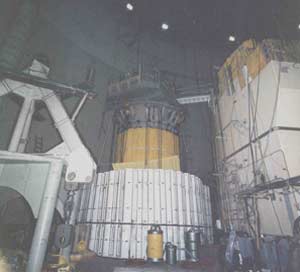Panic at Three Mile Island
The accident at the Three Mile Island Unit 2 (TMI-2) nuclear power plant near Middletown, Pennsylvania, on 28 March 1979, was the most serious in the history of American nuclear power, although it led to no deaths or injuries to plant workers or members of the nearby community. As a result of the accident and the ensuing panic, sweeping changes in emergency response planning, reactor operator training, human factors engineering, radiation protection, and many other areas of nuclear power plant operations were made. The accident also caused the United States Nuclear Regulatory Commission (NRC) to increase its regulatory oversight.
The accident was caused by a combination of factors such as equipment malfunctions, design problems, and operator mistakes. It led to significant damage to the reactor core but only very small off-site releases of radioactivity. The accident began about 4:00 a.m, when the plant experienced a failure in the secondary, non-nuclear section of the plant. The main feedwater pumps stopped running, caused by either a mechanical or electrical failure, which prevented the steam generators from removing heat. First the turbine, then the reactor automatically shut down. Immediately, the pressure in the primary system (the nuclear portion of the plant) began to increase. In order to prevent that pressure from getting too high, a relief valve opened. The valve should have closed when the pressure decreased by a certain amount, but it did not. Signals available to the operator failed to show that the valve was still open. As a result, the stuck-open valve caused the pressure to continue to decrease in the system.
Because adequate cooling was not available, the nuclear fuel overheated to the point where some of the zirconium cladding (the long metal tubes or jackets that hold the nuclear fuel pellets) reacted with the water and generated hydrogen. This hydrogen was released into the reactor containment building. By 30 March, two days after the start of the chain of events, some hydrogen remained within the primary coolant system in the vessel surrounding the reactor, forming a “hydrogen bubble” above the reactor core. The concern was that if reactor pressure decreased, the hydrogen bubble would expand and interfere with the flow of cooling water through the core.
Without water to cool the core, and with the top of the reactor core uncovered, the primary damage to the reactor occurred two to three hours into the accident. Although no “meltdown” occurred in the classic sense of the word (that is, fuel did not “melt” through the floor beneath the containment or through the steel reactor vessel) a significant amount of fuel did in fact melt. Radioactivity in the reactor coolant increased dramatically, and there were small leaks in the reactor coolant system that caused high radiation levels in other parts of the plant. Small amounts were also released into the environment. Shortly after the accident began, some of the water, carrying fuel debris and fission products, escaped from the reactor coolant system and flowed into the reactor building basement.
Response to the accident was swift. By 8:00 a.m., the NRC headquarters in Washington, DC, was alerted. At 9:15 a.m., the White House was notified and at 11:00 a.m., all non-essential personnel were ordered off the plant’s premises. Friday, 30 March, Governor Thornburgh of Pennsylvania ordered a precautionary evacuation of preschool children and pregnant women from within the 5-mile zone nearest the plant, and suggested that people living within 10 miles of the plant stay inside and keep their windows closed. Over 100,000 panic-stricken residents fled the area. Most evacuees were able to return to their homes by April 4. By that time, the situation at the reactor had been brought under control.
Comprehensive investigations have shown that in spite of serious damage to the reactor, most of the radiation was contained and that the actual release had negligible effects on the physical health of individuals or the environment.
By far, the greatest casualty of the accident at Three Mile Island was public confidence in nuclear power. The accident permanently changed both the nuclear industry and the NRC. Public fear and distrust increased, NRC’s regulations and oversight became broader and more robust, and management of the plants was scrutinized more carefully. Increased regulatory oversight has led to huge increases in the cost of operating nuclear plants and has led many utilities to cancel or abandon planned nuclear power stations.

